7 Common Yellow Birds (With Pictures): Info, Pics, Nesting, & Status
Last Updated on
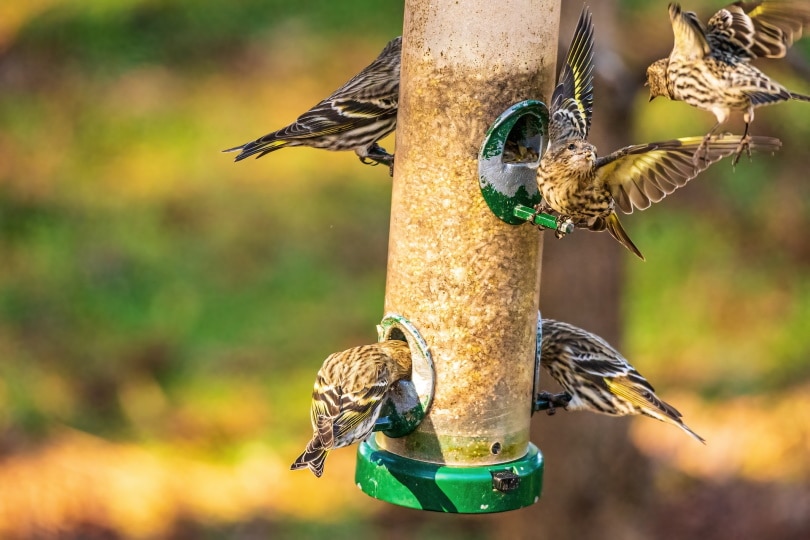
Birding is an incredible hobby. It’s one of those things that help you gain perspective in life, in addition to giving you reasons to smile. This will in turn help you create meaningful relationships, and thus live a long, happy, and fulfilling life.
Now that you understand why we love birding so much, it’s time to learn about the different bird species that are predominantly yellow in color. Can you think of one? Yes? Which one? The American Goldfinch? Okay, we’ll start with that one.

The 7 Most Common Yellow Birds
1. American Goldfinch
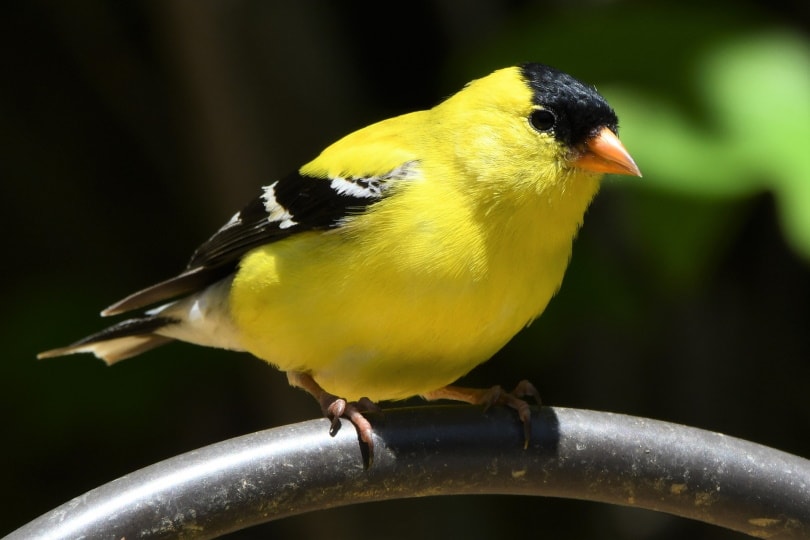
We all know the American goldfinch is the state bird of Washington. But it was not always Washington’s insignia. Before 1951, the state used the meadowlark. Its legislators decided to adopt a different bird because they wanted uniqueness. Or at least that’s what we are thinking. Several other states used the meadowlark as their crest symbol, and this didn’t augur well with them.
Unfortunately for them, that state symbol is still not unique to one state as Iowa and New Jersey are the other two states that use the American goldfinch as their official insignia.
Anyways, the American goldfinch is a tiny finch that mainly feeds on nyjer (thistle seed) and sunflower. If you’re not so sure where to find one, just look for Common Redpolls and Pine Siskins. These three species are like best of friends, seeing as they always flock together.
Nesting
When it’s time to build a nest, you’ll see the female frantically move around with their breeding partners at their side, looking for a habitable site. They don’t really like breeding in the forest interior, so don’t expect the nest to be in such a setting. It is likely going to be on a shrub of some sorts, or in an open area.
Protection Status
The American Goldfinch is a very common bird. But sadly, not as common as they used to be in the 50s and 60s. According to a bird breeding survey, the breeding population currently stands at 42 million. And a significant fraction of that population resides in the U.S.
As of now, they’re not in the State of The Birds Watch List, but they will be, if we keep on destroying their habitats and using pesticides that have harmful chemicals.
| Length: | 4.3–5.1 in (11–13 cm) |
| Weight: | 0.4–0.7 oz (11–20 g) |
| Wingspan: | 7.5–8.7 in (19–22 cm) |
- You might also like: 17 Finch Species Found in the United States
2. Bullock’s Orioles

We’re pretty sure you’ve seen one of these in a park somewhere, but you had no clue that that bird was the Bullock’s Orioles. They love breeding in urban parks and riparian zones. Or let’s just rephrase that in a different way:
If that area has large trees that are well spaced out, it’s a perfect Bullock’s Orioles habitat.
Their feeding habits are also typical for a bird its size. They’ll eat fruits, suck nectar, feed on insects, and maybe even arthropods if they feel like it. Bullock’s Orioles are masters of the gaping method. And they often employ this method whenever they’re trying to extract juice from fruits that have tough peel or rind.
To start, they’ll thrust that beak of theirs into the rind. They’ll then open it while it’s still in there, and extract the juice using their brushy tongue.
Nesting
Selecting the nesting site is the responsibility of the female. You’ll never ever see a male Bullock’s Orioles make an effort. She will choose a site, which has to be more than 10 feet above ground. Also, the area has to be isolated, with water nearby.
To discourage predators, they’ll make sure the nest is firmly suspended at the very end of a flexible branch.
Protection Status
The population of the Bullock’s Oriole has also dwindled since the 60s. They were, and still are, being affected by the chemicals used to manufacture pesticides, and habitat loss. Some of their breeding populations are found in Canada and Mexico, but more than 90% of the globe population is found in the U. S. And no, they’re not listed in any list of endangered species here, or anywhere else in the world.
| Length: | 6.7–7.5 in (17–19 cm) |
| Weight: | 1.0–1.5 oz (29–43 g) |
| Wingspan: | 12.2 in (31 cm) |
3. Nashville Warbler
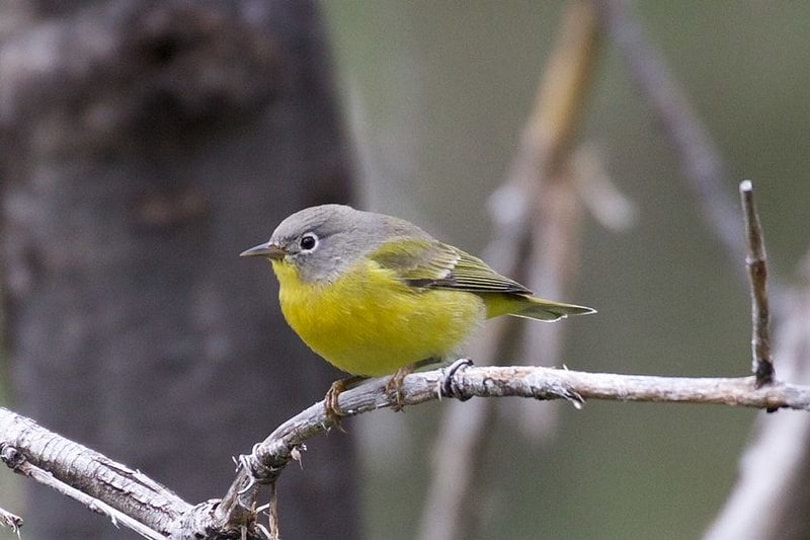
Because the Nashville Warbler is found in two very different regions, we often classify them as two subspecies. One of those subspecies is the Calaveras Warbler—also known as the New World warblers—and it’s the most common subspecies.
It‘s mostly found in the West Coast mountains, and mainly breeds in north-central North America. The other subspecies is called the Old World warblers. You’ll have to travel to Australia, Africa, or Eurasia, if you’re interested in studying or just viewing them.
Nesting
The Nashville Warbler always makes sure its nest is well hidden. And by the way, it takes more than 7 days to complete it. The construction materials will include grass, a few strips of bark, and sometimes moss. Normally, it’s 2 inches deep and 3.5 inches wide.
Protection status
Statistics indicate that the Nashville Warbler population was stable until 2015. Human interference, climate change, and loss of habitat are the causes of that sudden drop in numbers. Regardless, on the Continental Concern Score, the species has been rated 9th out of the 20 positions. Meaning, conservationists aren’t really that concerned about it at the moment.
| Length: | 4.3–5.1 in (11–13 cm) |
| Weight: | 0.2–0.5 oz (6.7–13.9 g) |
| Wingspan: | 6.7–7.9 in (17–20 cm) |
4. Orange Crowned Warbler

We again get to see region differences in the various bird species when talking about the orange crowned warbler. There’s a population that has inhabited the Pacific Slope, and one that’s in the Interior West. Those in the Pacific Slope share similar characteristics with the Yellow Warblers, with a few distinct features. They’re very bright and even more yellow compared to their counterparts in the Interior West.
Long story short, if you spot an orange crowned warbler with a yellowish-green or grey head, just know that’s NOT the orange crowned warbler, but the Interior West species. They also have white superciliaris, which is a complete contrast to the Yellow superciliary features of the Pacific Slope species.
Both of them prefer searching for food in low trees and dense shrubbery. That’s why it’s easy to spot one, even if you’re not looking.
What’s their main diet? Warblers like feeding on spiders, ants, and any other invertebrate prey that you can think of.
Nesting
When looking for an appropriate nesting site, the female will flutter through low vegetation. The perfect site can be gullies, shady hillsides, or trail cuts. As long as it’s on or close to the ground, it will do just fine.
Female Orange Crowned Warblers usually build their nests in a particular way. She will first lay down the foundation using coarse plant material, and a few dead leaves. Once that part’s done, it will move on to the outer layer, which is often constructed using moss, fine twigs, and leaves. To make it feel more comfortable, it will finally add animal hair or finer grass.
Protection Status
The Orange Crowned Warbler’s population has reduced by more than 30 percent since they were last counted in 1966. Ornithologists have attributed the decline to the use of harmful pesticides that have over the years, adversely affected their avian immune system. We’ve also come to learn that the reason why they aren’t endangered is because they’ve benefited from the practice of logging.
| Length: | 4.3–5.5 in (11–14 cm) |
| Weight: | 0.3–0.4 oz (7–11 g) |
| Wingspan: | 7.5 in (19 cm) |
5. Pine Siskin

Pine Siskins are opportunistic in nature. Even though they know how to forage like every other bird out there, they prefer hanging around heavier-billed birds that are known to be messy eaters, just to feed on the seeds that fall on the ground.
What if there are no messy-eaters, you ask? Well, when they aren’t taking advantage of such opportunities, they’re often busy searching for conifers such as spruce, cedars, and seeds of pine.
Pine Siskins migrate a lot. And by “a lot” we mean they’ll migrate on a whim. No reason at all. So, one minute they’ll be everywhere, and the next, they’ll be gone.
Also, compared to other birds, they are very sociable. And you can tell from a distance that they’re coming, if you keep quiet for a second and pay attention to their insistent wheezy twitters.
Here’s an interesting fact:
These birds have the ability to ramp up their metabolic rates for several hours, if the cold is too much to bear. It’s like they have thermostatic radiator valves inside them because those rates can go as high as 40% above that of a normal bird.
Nesting
When it’s time to start building, the female does all the heavy lifting while the male pretends to help. He’ll maybe supply a few materials and then go MIA. Only to return after 5–6 days, when all the construction work is done.
The nest usually looks like a shallow saucer, and it’s made of rootlets, grasses, and linches. We don’t know why, but for some reason, they like building these nests days or even weeks before they start laying eggs. And it’s pretty obvious they aren’t the most intelligent of birds, seeing as their nests are normally very vulnerable to gusty winds, and built on weak, flexible branches.
Protection Status
Due to their unpredictable movements, it’s not easy to estimate their exact numbers. However, it’s assumed that they’ve been on a steep decline since the 70s. That’s why if you take a quick look at the Continental Concern Score, you’ll see them listed as 10th—a position reserved for common birds that are on a steep decline.
| Length: | 4.3–5.5 in (11–14 cm) |
| Weight: | 0.4–0.6 oz (12–18 g) |
| Wingspan: | 7.1–8.7 in (18–22 cm) |
6. Yellow-Headed Blackbird
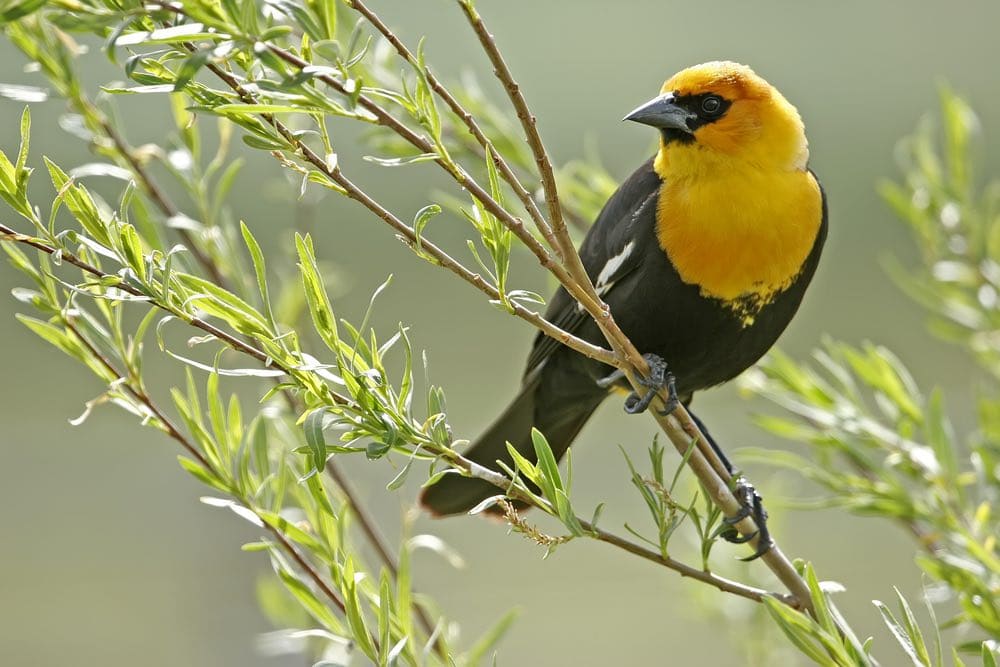
Quick question: Has your gate always made strange noises, but instantaneously stops the minute you step outside?
Well, the Yellow-headed Blackbird is the source of those rusty gate noises. Their wings will have a whitish patch, and the head will look golden.
Before 1820, we never knew these birds existed. It was Charles Lucien Bonaparte who spotted one, and proceeded to give a thorough description to our comrades, Sir John Richardson and Thomas Say.
Nesting
The female Yellow-headed Blackbird will construct her nest by herself. You’ll find it collecting wet vegetation from different water sources, before weaving them. Usually, the nest is 2.5 inches deep, and 3 inches wider on the inside. The outside will be approximately 5 inches wide.
Protection Status
The Yellow-headed Blackbird is not endangered. As a matter of fact, it’s one of the few bird species that have never been affected by the different human activities that have ravaged this planet.
Its population has been stable for years, and we don’t think that’s going to change any time soon. The breeding population is estimated at 11 million and a huge chunk of the number resides in the U.S.
| Length: | 8.3–10.2 in (21–26 cm) |
| Weight: | 1.6–3.5 oz (44–100 g) |
| Wingspan: | 16.5–17.3 in (42–44 cm) |
7. Yellow Warbler
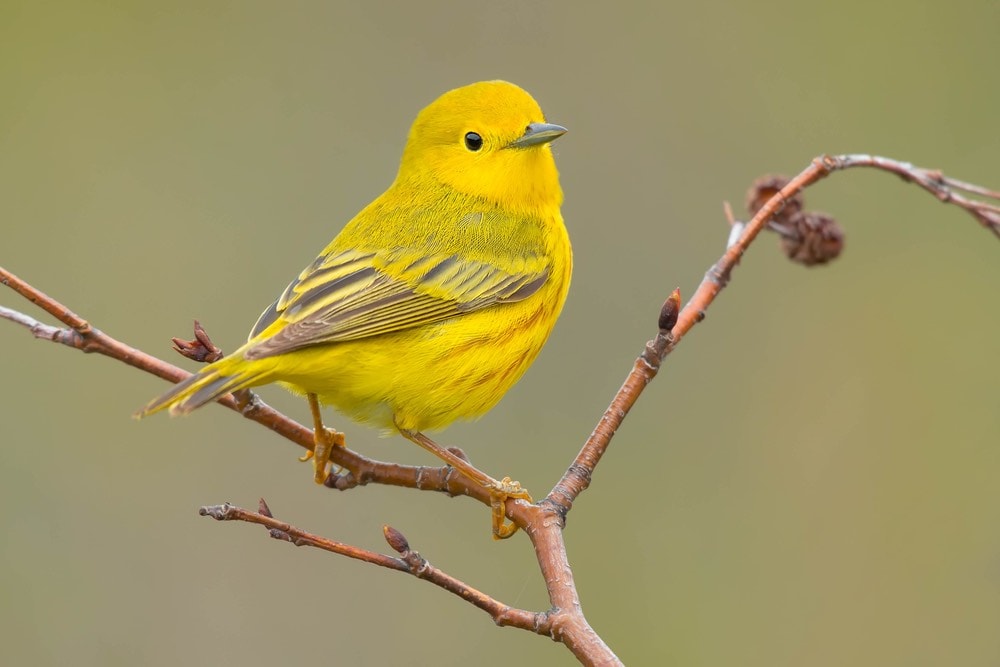
It’s quite easy to identify the yellow warbler. They all have round heads, thin beaks, medium-length tails, and are slightly larger than the American Goldfinch. The yellow color on the male will appear brighter than that found on their female counterparts, but both of them have unmarked faces.
During their breeding season, they’ll spend most of their time along streams and wetlands. They mainly feed on insects, including wasps, beetles, and caterpillars.
Nesting
It only takes the female four days to build a nest, and they always ensure it sits at least 10 feet above ground. If you’re interested in seeing how the nests look, look for a tree that has a vertical fork. The building materials will include spider webs, grasses, nettles, and even deer hair.
Yellow warblers hate sharing nests with other birds. When they realize something or someone has been messing around with the eggs while they were away, they’ll abandon the nest with the eggs and rebuild somewhere else.
Protection Status
Yellow warblers have been rated 6th on the Continental Concern Score. They aren’t endangered, but their population has declined by almost 25% since 1966. Most of them have migrated from the western U.S. to other parts of the country because apparently, there’s some grazing going on on that side, and it’s affecting their nesting habitats.
| Length: | 4.7–5.1 in (12–13 cm) |
| Weight: | 0.3–0.4 oz (9–11 g) |
| Wingspan: | 6.3–7.9 in (16–20 cm) |
Conclusion
That’s all we have for you today, folks. We enjoyed writing this piece on common yellow birds because it gave us an opportunity to not only share with you something that we’re passionate about, but to also remind you it’s our responsibility to help take care of the different species that haven’t gone extinct.
So, kindly help us raise awareness.
If you liked this article, check out some of our other top-trending birding posts:
- 7 Common Red Birds: Info, Pictures, Nesting Habits, & Protection Status
- 3 Proven Ways to Keep Sparrows Out of Bluebird Houses
- 2 Species of Eagles in Texas (with Pictures)
Featured Image Credit By: wileydoc, Pixabay
About the Author Robert Sparks
Robert’s obsession with all things optical started early in life, when his optician father would bring home prototypes for Robert to play with. Nowadays, Robert is dedicated to helping others find the right optics for their needs. His hobbies include astronomy, astrophysics, and model building. Originally from Newark, NJ, he resides in Santa Fe, New Mexico, where the nighttime skies are filled with glittering stars.
Related Articles:
How to Clean a Refractor Telescope: Step-by-Step Guide
How to Clean a Telescope Eyepiece: Step-by-Step Guide
How to Clean a Rifle Scope: 8 Expert Tips
Monocular vs Telescope: Differences Explained (With Pictures)
What Is a Monocular Used For? 8 Common Functions
How to Clean a Telescope Mirror: 8 Expert Tips
Brightfield vs Phase Contrast Microscopy: The Differences Explained
SkyCamHD Drone Review: Pros, Cons, FAQ, & Verdict

